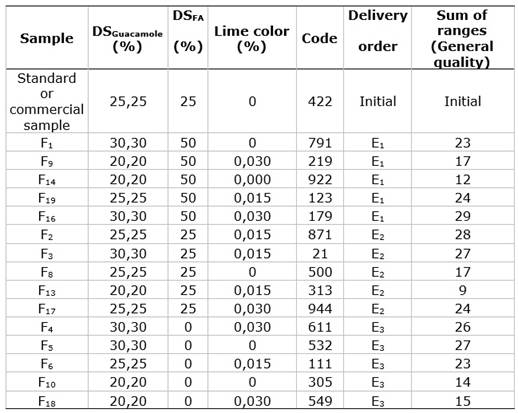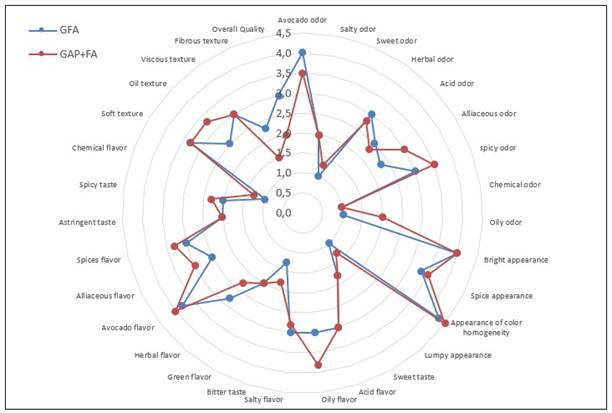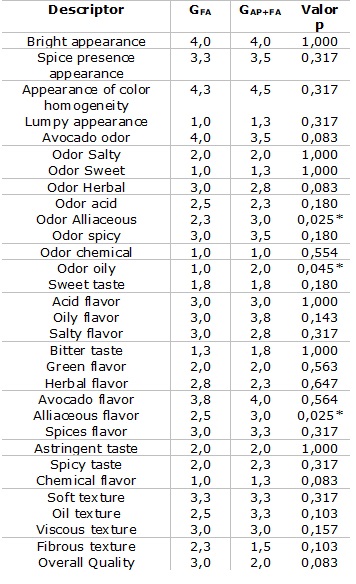INTRODUCTION
Sauces and salad dressings have been part of the human diet for thousands of years ago, they are used to flavor food, moisturizing and masking various culinary preparations [1]. Guacamole, making part of the Mexican dishes that mostly fit the range of "spicy dishes" is classified among the sauces and salad dressings, this category is extended to any product that has in its composition a high amount of Spice-flavored [2]. According to the Colombian technical guide [3], a food sensory analysis is an examination of physical and chemical attributes of a product that are perceived by the senses, allowing to know quantitative and qualitative properties of the food by trained panelists, and still fundamental for the development of new products with greater acceptance by consumers [4].
The main sensory characteristics that are taken into account to assess the quality and sensory shelf life of a sauce and salad dressings are attributes such as color, flavor, consistency, appearance, texture and overall quality [5]. The texture is one of the major qualitative parameters that can be seen by the senses of touch, sight, and hearing; It is related to the rheological properties and structure of foods [6]. The appearance or visual impression is the outward appearance that foods show, as the resulting expression of color, size, shape and quality status of food [7]. The taste and smell are perceived by chemoreceptors that can receive specific notes of taste and smell (taste + smell) for each food, like spicy attributes of dressings and sauces [8]. The pulp of ripe avocado which avocado is made with is characterized by having excellent sensory attributes, such as bright green moist creamy texture [9] and attributes of flavor as floral, herbal, green, sweet and oily, among others.
The aim of this study was to select by sensory methodologies a guacamole formulation made from avocado powder (AP) and fresh avocado (FA) (G AP+FA ), with quality attributes similar to a commercial guacamole made from 100% fresh avocado (G FA ).
METHOD
This research was carried out in the Laboratory of Sensory Food Analysis at the University of Antioquia. The average environmental conditions were 24.8 °C and 51% relative humidity.
Materials
Avocado powder (AP) was obtained by spray drying, according to the methodology described by Marulanda et al. (2018) [10]. For AP, avocado "Hass" (Persea americana Mill) from the eastern region of Antioquia was used; also, red onion (Allium cepa L.), paprika (Capsicum annuum), coriander (Coriandrum sativum), garlic (Allium sativum) and additives in the following categories: preservatives (sodium benzoate and potassium sorbate), antioxidants (Butyl hydroxytoluene and sodium erythorbate), acidulants (citric acid) and hydrocolloids like rubber xanthan were used.
Guacamole preparation
The formulation of the GAP+FA was prepared to reconstitute the AP at 50% of the water of the formulation, using a blender Kitchen Aid Artizana 194 rpm (position 6) for 4 min; then vegetables, spices, and additives previously disintegrated with the remaining water were added and stirred for 2 min.
Fifteen formulations obtained by combining the variables: dry solids of guacamole (DSGuacamole) (30,30 - 25,25 - 20,20%), dry solids provided by AF (DSAF) (0 - 25 - 50%) and lime color (0 - 0,015 - 0,030%) were evaluated. The statistical analysis was performed from the Friedman test.
The dependent variable was: sensory general quality of GPA+AF. First a discriminative test (ranking methodology), later, the sample with a best general quality was compere with a GAF through a descriptive test (sensory profile by multidimensional approximation, where descriptors of appearance, color, flavor and texture were evaluated).
General conditions for discriminative and descriptive trials
The trials were conducted in the Laboratory of Sensory Analysis of Food of Universidad de Antioquia, by means of a trained panel with and age range between 25 and 55 years, of male and female gender. Relative humidity conditions were recorded in the area of testing, at the beginning and end of the study. Cubicles separated and fitted according to regulations and white light were used. The regulatory framework for sensory analysis [3,11,12] was taken into account.
Discriminative sensory analysis
15 formulations were evaluated, with the participation of 7 trained judges, which were identified according to experimental design and in addition, a test code for each sample was designated. The formulas were strategically organized based on the guacamole soluble solids (DSGuacamole) in three groups with an E1, E2, and E3 delivery order. For each of these groups, it was conducted the methodology of ranking test, according to the general quality [13] and it was selected the one with the highest score of each group, in cases in which equal scores were obtained a pairwise comparison test [14] was carried out. Finally, a fourth group comprised of samples with the highest scores of the other three groups was submitted to the last ranking test, to choose the best formulation of the whole 15 samples collection. General quality analysis having the GFA as the pattern was considered.
Statistical analysis
For the four groups of formulas the Friedman test (Ftest) was applied (equation 1) to establish significant differences among the samples graded with respect to the overall quality, this considering that if Ftest > F, it is concluded that there are consistent differences between the ranks order. In case of finding minimum significant difference according to the Friedman test, it should be carried out a test of minimum significant difference (MSD) (equation 2). A null hypothesis where there is a significant difference between the sums of ranks of samples and an alternative hypothesis where there is a significant difference between the sums of ranks of samples are proposed.
Where: j =7 judges; R= sum of ranks for each sample; p” = number of samples.
Where: z = 1,96; j = 7 judges; p” = 5; significance level: 5%. If the absolute value of the difference between the sums of ranks of two products is equal to or greater than the MSD, it is concluded that the two products have received significantly different ranks.
Descriptive sensory analysis
The descriptive test was performed with the participation of 6 trained judges, who identified and selected sensory descriptors which enable the establishment of a sensory profile by a multidimensional approach for (GFA) and (GAP+FA) products, this last being selected throughout the discrimination analysis. Following the NTC 3932/1996 [14], it was initially performed a selection of descriptors in terms of appearance, smell, taste, and aroma of GFA and GAP+FA, then an assortment of the most representative descriptors was obtained by means of a group consensus, finally an intensity evaluation of the of each of these descriptors on an individual basis was carried out. The result of the entire assessment gives rise to a sensory profile and an overall quality of each product. Statistics were analyzed by using the Friedman test method.
RESULTS
Discriminative analysis
The conditions of temperature and relative humidity recorded during the sessions of sensory evaluation for the 15 formulations were: for the session 1: 25,2-25,9°C ((0,1°C) and 41,0-52,0% ((1,0%); and for the session 2: 23,0-25,0°C ((0,1°C) and 55,0-56,0% ((1,0%) respectively.
Table 1 describes the general quality of the guacamole formulations evaluated. The order from highest to lowest in terms of the overall quality of the four-valued groups was as follows:
Group 1 (F16, F19, F1, F9, F14): The Friedman test established minimum differences between these samples, therefore the test (MSD) was carried out, in which minimal differences between the samples of higher score were not found, then, a consensus was achieved among panelists on choosing F16 formula as the one with the greatest balance in smell and taste, also, soft, viscous and pasty texture attributes. Results: Ftest: 9,90 F*=9,11 and MSD = 11,59.
Group 2 (F2, F3, F17, F8, F13) significant differences with the Friedman test were found among these formulas, also, MSD test was performed, which no minimum significant difference among samples with highest scores was found. Then a pairwise comparison between F2 and F3 was performed. In terms of overall quality sample, F2 was chosen by its greatest balance in smell and taste, fleshy, doughy and viscose texture. Results: Ftest: 14,51, F*=9,11 and MSD = 11,59.
Group 3 (F5, F4, F6, F18, F10), no significant difference during the Friedman test were found, so F4 was selected by consensus among panelists on organoleptic attributes appointing out this formula as the one with the best slightly viscous texture, spicy and with more balance in taste and smell. Results: Ftest: 8,57 and F*= 9,11.
Group 4 (F2, F16, F4) significant differences with the Friedman test were found among these formulas, also, MSD test was performed, which no minimum significant difference among samples with highest scores was found. Then a pairwise comparison between F2 and F16 was performed. It was concluded, by the panelists, that both formulas have the greatest quality characteristics scores, and that there are no significant differences between them. Results: Ftest: 225,0, F*=9,11 and MSD = 7,33.
The comparison of F2 and F16 formulations in terms of increased use of AP was determining the relationship between DSAP and DSFA (DSAP/DSFA), which was 2,594 and 0,831, respectively. This result evidence that F2 formulation (DSGuacamole = 25,25%, DSFA = 25,0% and lime color = 0,015%) favors a greater use of the AP in the formulation. Now, by similarity with the commercial standard (GFA) as to the contribution of DSGuacamole and greater representation in the DSAP (%), was selected F2 (GAP+FA) to the descriptive test.
Descriptive test
Sensory analysis by multidimensional approach was performed to GFA and GAP+FA in a session with room conditions of initial temperature = 24,7°C and final 25,4°C, initial relative humidity of 55% and 60% at the end. The sensory descriptors obtained for GFA and G AP+FA based on parameters of appearance, color, flavor, texture, are set out in table 2 and figure 1.
For appearance and texture descriptors, it can be seen that no significant differences (p>0,05) were found. In descriptors evaluated for odor and taste, only attributes oily smell, alliaceum smell and alliaceum taste presented significant statistical differences (p<0,05). Attributes found for the guacamoles were the presence of spices, bright appearance and lumpy appearance among others. The spicy appearance, taste, and odor are typical of Mexican, Indian and some Asians sauces and dressings (Sheldrake, 2003). The lumpy appearance and fibrous texture are characteristic attributes of the guacamole, desired by the modern consumer that is also related to a more natural product. The homogeneity of the color appearance was given by the visualization of spice particles with their respective chromaticities, within the green bright avocado matrix [16]. Bright appearance of F2 is consistent with the oil content of avocado, which comprised the dispersed phase in the guacamole dressing; this descriptor was also been evidenced in dressings like mayonnaise [17].
Oily smell presented significant statistical difference (p<0,05) where GPA+FA acquired the highest score, which could be attributed to the physical form of the oil drops in GAP+FA inducing a greater perception of oily smell [18]. On the one hand, the raw material AP consists of droplets of oil below 50µ diameter which occupy a greater surface area in G AP+FA . On the other hand, the FA presents bigger drops of oil (millimetric) with considerable space between them as shown in the images of figure 2. The oily texture descriptor did not present significant statistical differences (p > 0,05) with respect to the two products. This parameter is characteristic of the oil emulsions in water, where the oily phase is responsible for providing attributes desired by the consumer as a creamy, soft, nutty and buttery flavor [9].
Alliaceous odor and taste attributes presented significant statistical differences (p<0,05) regarding both products, which is characteristic of the spiced garlic, that, in this case, was not expected (GPA+AF presented the highest score), since both products have the same spice proportion. This effect could be associated with the lower fat content of GPA+AF (28,9% db) versus GFA (55,8% db), due to the ability of the lipid fraction to capture or enhance flavors depending on the food matrix. First, the fat can form a barrier between taste compounds and taste receptors, resulting in a decrease in the intensity of the perceived flavor, this being a masking effect. Second, fat can increase the concentration of water-soluble flavor compounds in the aqueous phase, creating a mass with a greater flavor intensity (enhancer effect) [19].
There were no significant statistical differences (p>0,05) in the attributes of avocado taste and odor, with respect to both products. The result of great importance taking into account that PA is obtained with the spray drying technology that involves high temperatures, also several investigations have reported the loss of volatile compounds in avocado submitted to global warming [20]. Some of the common descriptors between the two products like green (unripe), herbal and spicy odor and taste, showed no significant statistical differences (p>0,05), which correlates with avocado characteristic flavor volatile compounds as Hexanal and E-2-Hexanal, found in the investigation of [21] in avocado pulp. Finally, the overall quality that corresponds to the global appreciation of the panelists regarding the quality of the products, did not present significant statistical differences (p>0,05) among.
CONCLUSIONS
The selected formulation through the sensory-discriminative analysis was F 2 by its greatest balance in smell and taste, pulpy, pasty and viscous texture, being the GAP+FA made with DSGuacamole: 25,25%, DSFA: 25% and lime color: 0,015%. The descriptive sensory analysis for GFA and GAP+FA did not show statistically significant differences based on odor and taste of avocado. It was possible to potentiate the spicy flavor of Tex-Mex products in the two products. Attributes obtained to assess sensory guacamole products serve as a reference for research where required sensory understanding and evaluating quality in salad dressings and sauces made of avocado.




















